|






| |
|
Retroreflective Mode Sensing |
|

How it Works:
Unlike an opposed-mode sensor, a retroreflective sensor contains
both the emitter and receiver elements. The effective beam is
established between the emitter, the reflector, and the receiver.
As with an opposed-mode sensor, an object is sensed when it
interrupts or "breaks" the effective beam. Most reflectors are made
up of many small corner-cube prisms. A light beam enters a corner
cube prism through its hypotenuse face and is reflected from the
three surfaces. In this way, the reflector returns the light beam to
its source. Most corner-cube reflectors resemble bicycle
reflectors, and are molded using clear acrylic plastic, manufactured
in various sizes, shapes, and colours. If an opposed-mode sensor is
not an option, then a retroreflective-mode sensor may be a good
second choice. Retroreflective mode sensors offer relatively long
ranges.
Reliable sensing
Retroreflective sensing is a beam-break mode. So, it is
generally not dependant upon the reflectivity of the object to be
detected. For this reason, the retroreflective mode is a relatively
reliable sensing mode.
|


Reflector Prisms |
|
Pros: Convenience
A
retroreflective-mode sensor offers a convenient alternative to
opposed mode when sensing is possible only from one side, or if
electrical connections are only possible on one side.
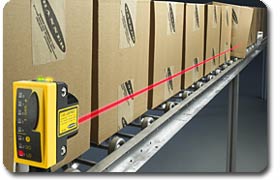
Convenient Connections
-At one end only
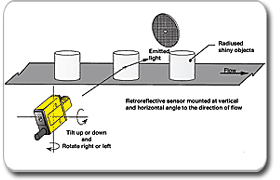
Minimising "Proxing" |
Cons: Less Excess Gain
Retroreflective-mode sensors lose excess gain twice as fast as
opposed-mode sensors, due to dirt build-up on both the reflector and
the sensor lenses. This is because the light travels through four
lenses, once from the emitter to the reflector and back from the
reflector to the receiver. There is also much less available excess
gain in a retroreflective mode sensing beam, due to the
inefficiencies of the reflector and because the light must travel
twice as far to reach the receiver, as compared to the opposed mode.
Cons:
Effective Beam
It's
difficult to create a small effective beam with a retroreflective
mode sensor, so avoid using this mode for detecting small objects or
for precise positioning control. We can offer some retroreflective
sensors that have an effective beam of less than 25mm.
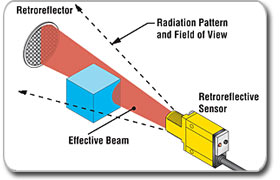
Effective Beam
Cons:
Clear Materials
In the
retroreflective mode, an object must interrupt the beam to be
detected. As with opposed mode, it is not recommended that you use a
retroreflective mode sensor to detect transparent or translucent
objects.
However there are several sensors designed specifically as clear
object detectors in low excess gain environments.
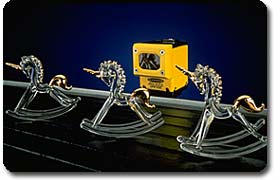
Clear Objects
Cons:
Shiny Materials
The optics of a good
quality retroreflective sensor are designed and assembled with great
care to minimize "proxing" (undesirable reflection of the
sensing beam directly back from an object that is supposed to break
the beam). However, an object
with a shiny surface that presents itself perfectly parallel to a
retroreflective sensor may return enough light to cause that object
to pass by the sensor, undetected. This problem can be compensated
for by angling the sensor relative to the object to avoid direct
reflection or by using an anti-glare or polarizing filter.
Cons: Reflector Size
and Type
Except at close range, the size of the reflector becomes important.
The width of the beam pattern for each retroreflective sensor serves
as an estimate of how much reflector area should be used to return
the maximum amount of light. Reflector size does affect the range.
The smaller the target size, the smaller the effective beam, and the
shorter the range.
Also the efficiency of different reflector material types varies
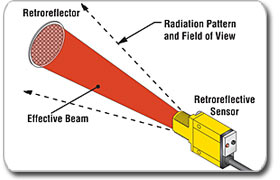
Reflector Size
Cons:
Blind Spot at Close Range
Most
retroreflective sensors are designed for long-range sensing, and
suffer a "blind spot" at close range. A
"Blind Spot" is an area close to a sensor lens, where light energy
is returned to the emitter rather than the receiver, rendering the
sensor effectively blind. This effect is most pronounced with some
retroreflective sensors.
Check the excess
gain curve of your retroreflective mode sensor to see where the
"blind spot" occurs.
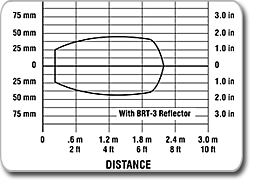
Blind Spot
|
Application - Cardboard
Box Detection
Objective:
To reliably
count boxes moving on a high-speed conveyor line.
The retroreflective optics of a MINI-BEAM sensor are excellent for
reliably sensing boxes on a conveyor belt. This sensor generates one
solid count from each box moving through the beam.
|
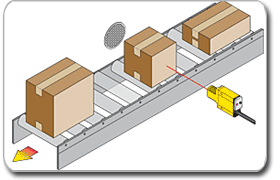 |
|
Review
A retroreflective
sensor contains both the emitter and receiver element. The
effective beam is established when the emitter sends a light beam
which is bounced off a retroreflector, back to the emitter. An
object is detected when it breaks this effective beam.
Retroreflective-mode sensors offer reliability, and are convenient
in applications where sensors can be mounted only on one side of a
process. However, retroreflective sensors can lose gain twice as
fast as opposed mode sensors, and they aren't always the best choice
for sensing shiny, clear, or very small objects.
NEXT |
|